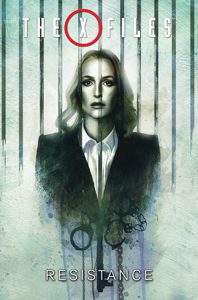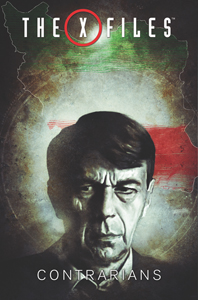Writer Joe Harris gives readers a refreshing break from the dense mythology to start off the final year (for now) of “The X-Files’ ” ongoing title. Oddly enough, it’s through two mythology-tinged stories. But they are character-heavy flashbacks to the Cigarette Smoking Man and Skinner, so they are easier to digest. Then it’s on to the finale to end all finales (again, for now). Here’s a look at Issues 10-17, from 2017:
“Contrarians” (Issues 10-11, collected in “Contrarians” TPB)
The inventors of the Cigarette Smoking Man probably weren’t thinking about this back in the day, but one of the advantages of a villain who always smokes is we can easily spot him in comic panels. The art by Greg Scott (pencils and inks) and Wes Dzioba (colors) is quite good – I like the gray flashbacks that indicate both time and mood – but the smoking helps a reader quickly distinguish the CSM from Bill Mulder.
“Contrarians” takes us back to the Iran-Contra Affair of the 1980s starting with a tasty sequence wherein President Reagan is conversing with the CSM before going on the air to rationalize with/apologize to the American people. Harris does a nice job of balancing Reagan’s complicity with the Syndicate with his disgust for its existence and tactics.

“X-Files” ongoing Issues 10-17 (2017)
Publisher: IDW
Writer: Joe Harris
Artists: Greg Scott, Wes Dzioba, Andrew Currie, Sebastian Cheng, Matthew Dow Smith, Jordie Bellaire
While this is a nice way to get a history lesson, the story ends up being about an alien spaceship that has crash-landed in Nicaragua, long enough ago that it is covered with grass and has blended into the landscape. The CSM uses the USA’s Iran-Contra allies in the country to blow up the ship and destroy the evidence.
In present day, a ghost of a Nicaraguan rebel general leads Mulder to a Baltimore warehouse full of cocaine. Presumably this stash will retroactively implicate the Syndicate, or something like that. A little more clarity here would’ve been nice.
But the joy of “Contrarians” simply comes from listening to the CSM and Bill gab in their usual fashion. For all of Harris’ faults as a storyteller, characterization of “X-Files” icons is not among them, and “Contrarians” is the best of the ongoing series’ arcs.
4 stars
“Skinner” (Issues 12-13, collected in “Contrarians” TPB)
An unintentional companion piece to “Kitten” (11.6), which would air the following year, “Skinner” has the pleasant surprise of new revelations about our favorite – to borrow Mulder’s word – establishmentarian. Rather than being an unambiguous hero, Skinner – nicely rendered by Andrew Currie (art) and Sebastian Cheng (colors) in past and present scenes (the glasses help us spot him, just like the smoke helps us spot the CSM) — is re-established as a gray-area figure in “X-Files” lore.
In flashbacks to a military hearing in the wake of the Vietnam War, we see that Skinner tells the unadorned truth about what he saw in a jungle incident rather than lying to defend his brothers in arms. He – and we as readers – struggle with whether this is misplaced morality.

I like the idea of the ancient religious talisman, discovered in the Vietnam jungle, being the inciting device and also the thing that haunts the soldiers years later; it’s a literal symbol of PTSD. Harris could’ve made it clearer what happens on that fateful wartime day, though, as this isn’t the crispest story he’s ever told.
I was happy when a soldier flat-out tells Skinner that the talisman always finds its way back to him, just so that part of the tale is cleared up, at least. On the other hand, if “Skinner” leaves readers with the impression that the Vietnam War was a terrifying and confusing mess, I suppose it has done its job to some degree.
I’m not sure if I should dock or applaud Harris for this element: Skinner can hear the talisman in his head, calling his name. Close to 100 percent of readers will imagine “The Simpsons’ ” Superintendent Chalmers calling out “Skinnerrr!”
Ultimately, we can add this story to our mental X-File about the FBI assistant director. We get more of a feel for why he’s always vaguely haunted and morose (which seems to be the main purpose of Skinner yarns).
That said, I think this story could’ve been stronger: Harris shies away from getting deep in the weeds of what exactly takes place in the Vietnam incident. It’s understandable that Skinner is confused and disoriented, but I think readers could’ve been let in on a little more of the truth.
3.5 stars

“Resistance” (Issues 14-17, collected in “Resistance” TPB)
Less than two years earlier, Harris had to wrap up a truncated Season 11 because “The X-Files” was returning to TV. And here he finds himself wrapping up a truncated ongoing series based on the TV revival because of low comic sales. Again, he does a fairly respectable job, with regular artists Matthew Dow Smith (pencils, inks) and Jordie Bellaire (colors) back in the fold.
“Resistance” feels like an “X-Files” mythology episode in every way, but – like the not-so-great TV episodes – I come away from it enjoying my experience of reading it yet not absorbing anything. I’ll type up my impressions here, but once some time passes, I’ll have no hope of recalling off the top of my head what happens in this arc or why it matters.
In a smart use of the comics medium for something that couldn’t easily be done on TV, Harris peppers in a bit of a Trump satire. It marks the second time in the ongoing series — along with “Contrarians,” featuring Reagan — that he uses a real-world president. Trump announces to the National Security Council that he’s adding some “impressive, admirable” people to the team. They turn out to be murderous alien shapeshifters.
Starting with Mulder’s pro-gun-control rant in Issue 1, Harris sometimes peppers Democratic Party politics into his “X-Files” stories, something that’s a bit off-putting since Chris Carter’s TV series generally does a great job of focusing on why the government (rather than a specific party) shouldn’t be trusted.
The most party-political it gets is the awkward moment in “I Want to Believe” when the theme music pointedly plays over George W. Bush’s portrait. That said, Harris uses Reagan and Trump to fine effect, in my opinion, although I suppose it’s inevitable that some readers will be offended or at least distracted.
I’m more distracted by the confusing, vague nature of the storytelling. Firas Ben-Brahim – a powerful mover-and-shaker who might turn out to actually be a good guy – tells Mulder and Scully that the “holes in the sky” lights filling possessed people’s eyes (dating back to Issue 1) are a continuation of the Black Oil, a.k.a. Purity. So what I initially thought was a ripoff of the Black Oil storyline is just more of the Black Oil storyline.
We learn that Ben-Brahim is the son of Conrad Strughold (from “Fight the Future”), thus allowing for a parallel with Mulder: Their parentage might be murky, but it’s up to individuals to do the right thing regardless of their lineage.
“Resistance” resolves when an alien ship rises out of the Sea of Japan, thus averting a USA-versus-North Korea war. As far as what the aliens’ goals are, I have no idea. As with a lot of Harris’ mythology work, it really is work trying to figure it all out. That said, he always has our favorite agents very much in character – Mulder quipping till the end, in just the right amount.
The author uses “Resistance” as a grace note, with Mulder and Scully expressing their appreciation for each other after this latest life-or-death escapade — the idea of a romance between Scully and Ben-Brahim having been slightly teased earlier, to Mulder’s ire.
If “The X-Files” returns to TV for a third miniseries, it’s possible that this ongoing series will retroactively become the second “canon but now no longer canon” series. So Harris could’ve gone ahead and blown up the Earth if he had wanted to. That would’ve been overwritten by the 2018 episodes, but at least then “Resistance” wouldn’t be just another mythology arc, and I’d remember it more.
3.5 stars

